Ancient Ice Core Reveals Genomes of 1,700 Viruses
Scientists from the United States have made a remarkable discovery of over 1,700 ancient viruses in ice core samples taken from the Guliya Glacier on the Tibetan Plateau. Some of these viruses are over 40,000 years old. The study, led by Zhi-Ping Zhong of Ohio State University, offers valuable insights into how viruses have evolved and survived in response to changing climates.
Ice Core Sampling
Ice cores are cylindrical samples drilled from glaciers, which allow scientists to study layers of ice that have built up over thousands of years. Each layer holds important environmental information, including preserved microorganisms like viruses. The ice core from the Guliya Glacier is 310 meters long and provides samples from different climatic periods, making it a valuable resource for studying ancient climates and viral history.
Genomic Analysis
The research team used advanced techniques to extract DNA and sequence the genomes of the viruses found in the ice. They identified 1,705 different species of viruses, each showing significant genetic differences based on the climate conditions when they were active.
Viral Communities and Adaptation
The study revealed that some viral communities were unique to the region and were particularly active around 11,000 years ago during periods of climate change. These viruses showed remarkable adaptations, such as acquiring genetic material from the bacteria they infected (like Flavobacterium) to improve their own survival and metabolic functions.
Evolutionary Insights
The analysis showed a strong connection between viral activity and climate change. This suggests that as the climate shifted, new viruses emerged, putting pressure on existing strains to evolve. This kind of evolutionary interaction may have played a key role in shaping viral populations over time.
As global warming causes glaciers and permafrost to melt, there is a growing concern that ancient viruses, long trapped in ice, could be released into modern environments. This poses potential health risks, as these ancient viruses might interact with current ecosystems in unpredictable ways. Further research is needed to understand how these viruses behave and adapt.
Importance of the Research
This study highlights the importance of collecting and analyzing ice core samples from around the world, especially as glaciers continue to melt. These ice cores contain critical information about past viral and climate interactions, which could be lost forever if not studied soon. Understanding these ancient viruses is essential for predicting how they might respond to current and future climate changes in the Anthropocene era—the current period in which human activity is the dominant influence on climate and the environment.
Month: Current Affairs - September, 2024
Category: Environment Current Affairs








